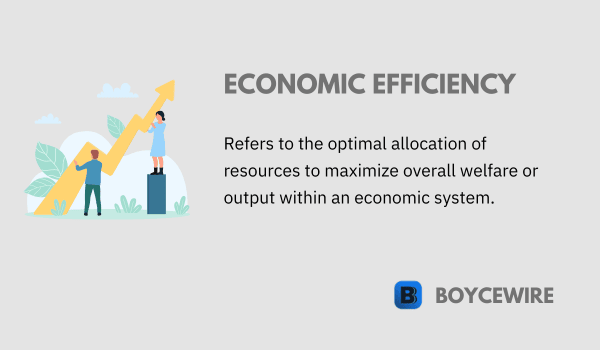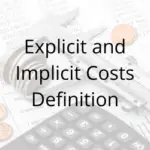Economic Efficiency: Definition, Types, Measurement & Examples

What is Economic Efficiency?
Economic efficiency, a fundamental concept in economics, serves as a barometer of the overall health and productivity of an economy. It is a state where resources are allocated in a manner that maximizes the net benefit accrued to society, accounting for every available preference. In essence, it is about doing the best with what we have, ensuring that resources are not wasted or used inappropriately.
Economic efficiency plays a crucial role in determining the wealth and prosperity of nations. Its importance transcends the field of economics, influencing decision-making processes in businesses, public policies, and even individual consumption and investment choices. The intricate dynamics of this concept and its various types, such as productive, allocative, and dynamic efficiency, provide a framework for understanding and enhancing the economic performance of different sectors and the overall economy.
Key Points
- Economic efficiency refers to the optimal allocation of resources to maximize overall welfare or output.
- It involves achieving the highest possible level of production or utility with the available resources.
- Economic efficiency is measured by comparing the actual outcome to the theoretically efficient outcome.
Understanding Economic Efficiency
Economic efficiency is an economic state in which every resource is optimally allocated to serve each individual or entity in the best way while minimizing waste and inefficiency. In a well-functioning economy, any modifications aimed at benefiting one entity would have adverse effects on another. This concept encompasses various types of efficiency:
- Allocative Efficiency This occurs when consumers are getting the maximum possible satisfaction from the goods and services available. It represents the allocation of resources that consumers would choose if they were in charge of resource allocation.
- Productive Efficiency This happens when a good or service is produced at the lowest possible cost. It involves using essential inputs and applying efficient processes and technology.
- Dynamic Efficiency This form of efficiency focuses on the optimal rate of innovation and technological progress. It improves productive efficiency over time and leads to better quality products, lower costs, and increased choice for consumers.
- Pareto Efficiency A state is Pareto efficient when no individual can be made better off without making someone else worse off. It’s a resource allocation from which it’s impossible to move without harming at least one individual.
In reality, achieving complete economic efficiency, especially allocative efficiency, is often considered a theoretical benchmark rather than something attainable in practice. Nonetheless, the concept serves as a tool to compare the implications of different economic policies and systems. Striving for such efficiency is generally regarded as an important economic goal in evaluation and policy analysis.
Types of Economic Efficiency
Economic efficiency manifests in various forms, each with specific implications and applications. Familiarity with these different types enhances the ability to assess the efficiency of economic systems and processes. Here are the main types of economic efficiency:
- Productive Efficiency This type of efficiency occurs when a firm produces goods and services at the lowest possible cost. It is achieved when a company operates at the minimum point of its average cost curve, where marginal cost equals average total cost.
- Allocative Efficiency Allocative efficiency is achieved when goods and services are distributed or allocated in a manner that maximizes societal benefit. It aligns the allocation of resources precisely with consumer preferences, ensuring production up to the point where the marginal benefit to consumers equals the marginal cost of production.
- Dynamic Efficiency Dynamic efficiency concerns the optimal distribution of resources over time. It involves striking a balance between investing in current production and investing in future growth, such as research and development, technological advancement, and capital investment. Dynamic efficiency emphasizes the role of innovation in driving efficiency.
- Social Efficiency Social efficiency occurs when goods and services are produced and consumed in a manner that maximizes total welfare in society. It considers both private costs/benefits and external costs/benefits. Social efficiency is achieved when the socially optimal quantity of a good or service is produced.
- X-efficiency X-efficiency arises when a firm produces output at the minimum possible cost given the technological constraints. It materializes when firms eliminate waste and utilize resources in the most effective manner.
An understanding of these different forms of efficiency empowers policymakers, businesses, and individuals to make informed decisions that maximize economic utility and minimize waste.
Measurement of Economic Efficiency
Measuring economic efficiency is a complex task, and different methods are used to assess different types of efficiency. Here are some common ways to measure it:
- Productive Efficiency Productive efficiency can be measured by comparing the total costs of production with the total outputs. A more productive company can generate more output for the same input or the same output with fewer inputs.
- Allocative Efficiency Allocative efficiency is determined by market equilibrium, where supply equals demand. In a perfectly competitive market, prices reflect allocative efficiency. If the price of a good corresponds to the point where the marginal cost of production equals the marginal benefit to society, allocative efficiency is achieved.
- Dynamic Efficiency Dynamic efficiency, which focuses on efficiency over time, is challenging to measure. One common measure is the rate of innovation and technological progress. Metrics such as research and development expenditure, patent counts, and rates of technological adoption provide insights into dynamic efficiency.
- Social Efficiency Social efficiency can be assessed by measuring the net effect on society, comparing social costs with social benefits. Economic techniques like cost-benefit analysis attempt to quantify the costs and benefits of specific actions to society.
- X-Efficiency X-efficiency can be measured by comparing a company’s actual output to the maximum achievable output with the same level of inputs.
It’s important to note that these measurements are often based on assumptions and can be influenced by factors such as market structure, information availability, and property rights. Therefore, interpretation should be done with caution.
Influencing Factors of Economic Efficiency
Economic efficiency is influenced by various factors, both endogenous and exogenous to the economic system. Several key factors can impact it:
- Market Structure The structure of the market, whether perfectly competitive or monopolistic, can significantly affect economic efficiency. Perfectly competitive markets tend to achieve higher allocative and productive efficiency compared to monopolies or oligopolies.
- Government Policies Government regulations and policies can impact efficiency. Well-designed policies that promote competition and protect consumers can enhance efficiency, while excessive regulation or inefficient subsidies can hinder efficiency.
- Technological Progress Technological advancements can greatly enhance productive efficiency by enabling more output with the same inputs. Technological progress also improves dynamic efficiency by encouraging innovation and economic growth over time.
- Information Availability In an efficient market, all participants have access to relevant information. Information asymmetry, where one party has more information than others, can lead to inefficiencies and suboptimal outcomes.
- Externalities External costs or benefits affecting third parties can lead to economic inefficiency by creating a divergence between private and social costs/benefits.
- Property Rights Clearly defined and enforceable property rights are essential for economic efficiency. They provide incentives for investment, innovation, and mutually beneficial trade.
These factors collectively influence the level of economic efficiency within an economy or market. Policymakers and economists should consider these factors when striving to improve the economies efficiency.
Economic Efficiency in Practice
While the concept of economic efficiency is straightforward in theory, achieving it in practice can be complex. Here’s how it plays out in the real world:
- Policy Design and Implementation Governments aim to improve economic efficiency through policies such as promoting competition, reducing wasteful spending, and addressing externalities. However, policy design and implementation must consider potential unintended consequences and ensure that benefits outweigh costs.
- Technological Innovations Technological advancements continuously improve productive efficiency across industries. Automation, AI, and digital transformation have increased output with the same inputs, leading to greater efficiency in manufacturing and services.
- Market Forces Competitive markets drive firms to become more efficient to survive and thrive. Firms optimize operations, invest in new technologies, and innovate products and services, increasing overall economic efficiency.
- Challenges Obstacles to economic efficiency persist, such as market failures, job displacement due to technological progress, and unintended inefficiencies from certain government interventions.
- Balancing Efficiency and Equity Policymakers must balance efficiency with other objectives like equity and sustainability. Trade-offs and careful policy decisions are necessary to address income inequality and ensure a balanced approach.
In practice, achieving economic efficiency involves navigating these complexities and making informed decisions that consider the specific circumstances and objectives of an economy or market.
Limitations of Economic Efficiency
- Static Concept It is a static concept that captures efficiency at a particular point in time. However, economies are dynamic and constantly changing, making it challenging to maintain efficiency over time.
- Assumptions It relies on assumptions like perfect competition, no externalities, and full information availability, which rarely hold in the real world.
- Equity Considerations Economic efficiency does not consider the distribution of resources, leading to potential inequities in society.
- Measurement Challenges Measuring it can be difficult, especially when quantifying aspects like allocative efficiency.
- Unaccounted Externalities It’s challenging to account for all externalities, including non-market externalities such as environmental impacts, which can lead to an overestimation of economic efficiency.
- Behavioral Aspects Traditional theory assumes rational economic agents, but behavioral biases can impact decision-making and deviate from rationality.
These limitations highlight the need for caution when applying economic efficiency concepts and the importance of considering other economic and social indicators to guide policy decisions and business strategies.
Examples of Economic Efficiency
- Productive Efficiency in Manufacturing A car manufacturing plant that utilizes advanced technology and efficient processes to minimize waste and maximize output, achieving productive efficiency.
- Allocative Efficiency in Markets A perfectly competitive market where prices reflect marginal costs, allowing resources to be allocated based on consumer preferences.
- Dynamic Efficiency in the Tech Industry The tech industry, known for its rapid innovation, continuous investment in research and development, and quick adaptation to market trends, demonstrating dynamic efficiency.
- Pareto Efficiency in Trade Two trading countries specializing in goods they are efficient in producing, leading to mutually beneficial trade and a situation where no one is worse off and at least one is better off, reflecting Pareto efficiency.
- X-Efficiency in Competitive Markets Companies in highly competitive markets that operate at maximum potential to minimize costs, enhance efficiency, and remain competitive.
These examples illustrate how economic efficiency can be observed in different sectors and contexts, promoting productivity, optimal resource allocation, innovation, and beneficial trade. However, it’s important to consider the limitations and the potential trade-offs with equity and sustainability.
FAQs
Economic efficiency pertains to the ideal distribution of resources to maximize overall well-being or production.
Economic efficiency is measured by comparing the actual outcome to the theoretically efficient outcome.
Various forms of economic efficiency exist, encompassing allocative efficiency, productive efficiency, and dynamic efficiency.
Factors such as market competition, effective resource allocation, technological advancements, and favorable government policies contribute to economic efficiency.
About Paul
Paul Boyce is an economics editor with over 10 years experience in the industry. Currently working as a consultant within the financial services sector, Paul is the CEO and chief editor of BoyceWire. He has written publications for FEE, the Mises Institute, and many others.

Further Reading
 Explicit and Implicit Costs: Definition & Examples - An explicit cost is the clearly stated costs that a business incurs. For example, employee wages, inputs, utility bills, and…
Explicit and Implicit Costs: Definition & Examples - An explicit cost is the clearly stated costs that a business incurs. For example, employee wages, inputs, utility bills, and…  Price Gouging: Definition & Examples - Price gouging is where the seller increases the prices of their goods or services to a level considered unreasonable and…
Price Gouging: Definition & Examples - Price gouging is where the seller increases the prices of their goods or services to a level considered unreasonable and…  Third Degree Price Discrimination: Definition, Examples & Graph - When business charge customers different prices based on their demographic or other characteristic.
Third Degree Price Discrimination: Definition, Examples & Graph - When business charge customers different prices based on their demographic or other characteristic. 
